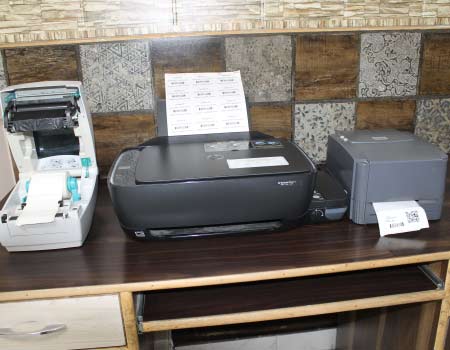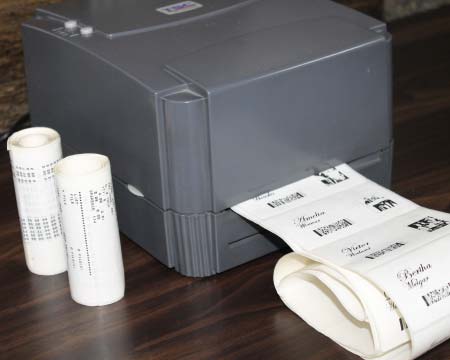Network Connected Barcode Printer
Connecting a barcode printer to a network can provide a powerful and flexible labeling solution for a variety of applications.Using a network-connected barcode printer can provide several benefits, including centralized control and management, reduced costs, and improved efficiency. It can also help ensure consistency in labeling and reduce the risk of errors, as all users will be using the same label formats and data.
Last Updated On:
Introduction Of Barcode Printer Connect to a Network
Barcode printers can connect to a network in a few different ways, including Ethernet, Wi-Fi, or Bluetooth. Ethernet is the most common method, and most barcode printers that support network connectivity will have an Ethernet port built-in. Wi-Fi and Bluetooth connectivity are also available on some models, providing additional flexibility and mobility.
Once connected to the network, a barcode printer can be accessed by any authorized user or device on the network. This can be done using software that allows for remote printing, or through a web interface that allows users to submit print jobs to the printer.
Barcode Printer Print Different Sizes Of Barcodes
Yes, barcode printers can print different sizes of barcodes, and the size of the barcode can be adjusted based on the specific requirements of the application.
❖ The size of a barcode label can vary depending on the amount of data that needs to be encoded, the type of barcode being used, and the size of the item being labeled. For example, a small product may require a small barcode label, while a large shipping box may require a larger label.
❖ Most barcode printers have adjustable settings that allow for the size of the barcode label to be customized. The size of the barcode can be adjusted by changing the print resolution, adjusting the size of the label itself, or by changing the scaling or sizing settings within the barcode software.
❖ Barcode printers can connect to a network and be shared among multiple users or devices. This can be particularly useful in environments where multiple users need to print barcode labels from different locations, such as in a warehouse or distribution center.
It's important to note that while the size of the barcode can be adjusted, there are limits to how small or large a barcode can be printed and still be readable by a scanner. For 1D barcodes, the minimum size can depend on the barcode type and the scanner used, but generally, a minimum height of 0.25 inches (6.35 mm) is recommended. For 2D barcodes, the size requirements are generally less restrictive due to their ability to encode more data in a smaller space. Read More

Barcode Printer Print Custom Designs or Logos with Printer
No, a barcode printer only prints the barcode itself and not any additional graphics or designs. However, some barcode label software may allow you to customize the appearance of the barcode label, such as adding text or changing the font, size, or color. If you want to add a logo or custom design to your label, you may need to print the barcode label separately and then affix it to a pre-printed label that includes the desired design or logo.
➲ Can a Barcode Printer Print Different Types Of Barcodes
Yes, barcode printers can print different types of barcodes, including both 1D and 2D barcodes.

✔ Barcode printers can be programmed to print a variety of barcode types, such as UPC, EAN, Code 39, Code 128, QR codes, and Data Matrix codes. The specific barcode types that a printer can support will depend on the printer model and the software it uses.
✔ Some barcode printers can also print multiple barcode types on the same label, allowing for more efficient and flexible labeling. For example, a label may include both a 1D barcode for product identification and a 2D barcode for tracking and inventory management.
✔ Barcode printers can also be used to print labels with customized information such as logos, text, and graphics. This can be useful for creating product labels, shipping labels, and asset tags that include both barcode and human-readable information.
Overall, barcode printers are a versatile tool for creating a wide variety of barcode labels for use in inventory management, asset tracking, and other applications.
➲ Can a Barcode Printer Integrated with Software Applications
Yes, barcode printers can be integrated with other software applications, such as inventory management systems, shipping software, or ERP systems, to automate and streamline label printing processes.

✔ Integration can be achieved through several methods, such as using a software development kit (SDK) provided by the printer manufacturer, using third-party middleware, or by using the printer's built-in network interface.
✔ By integrating a barcode printer with other software applications, users can automate the label printing process and reduce the risk of errors. For example, when an item is received in a warehouse, the inventory management system can automatically generate a label with a unique identifier and other relevant information, and send it to the barcode printer to be printed and applied to the item.
✔ This type of integration can save time and reduce the need for manual data entry, as information can be automatically transferred between systems. It can also help ensure consistency in labeling and reduce the risk of errors, as all labels will be generated and printed using the same data.
Overall, integrating a barcode printer with other software applications can provide a powerful and efficient labeling solution for a variety of industries and applications.
Integrate Barcode Printer with Existing Software Applications
Yes, you can integrate a barcode printer with your existing software applications. There are various ways to do this, depending on the software and hardware you are using.
Here are some ways that you can integrate a barcode printer with your existing software applications:
| Printer drivers: Most barcode printers come with drivers that allow you to print directly from your software applications. You can download and install the printer driver on your computer, easy way it is reliable and which will enable your software applications to print to the barcode printer. | Barcode software: Barcode software can be used to create and print barcode labels. Some barcode software can also be integrated with other software applications, allowing you to print barcode labels directly from your existing software. |
| API integration: Some barcode printers come with APIs (Application Programming Interfaces) that allow you to integrate them with your software applications. This enables you to control the barcode printer directly from your software, allowing you to print labels automatically. | Middleware integration: Middleware software can be used to connect your software applications to your barcode printer. This allows you to print labels directly from your software applications, without the need for manual intervention. |
Overall, integrating a barcode printer with your existing software applications can streamline your label printing process and improve accuracy and efficiency. The method you choose will depend on the software and hardware you are using, as well as your specific requirements.